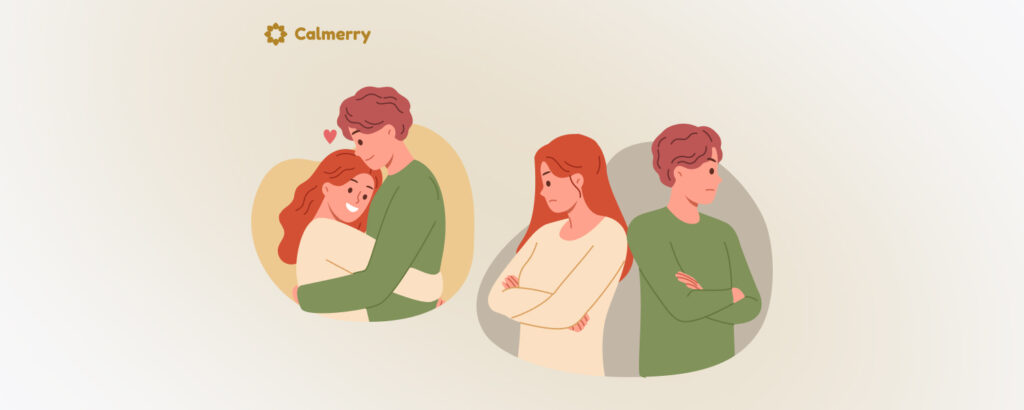Signs and Examples of Trauma Bond and What to Do About It

In this article
In the summer of 1973, a bank robbery occurred in Stockholm, Sweden, where four bank workers were taken hostage for six days.
Over that period, it’s said that the workers began to develop a bond with the robbers, which grew so strong that one of the captives told the Swedish Prime Minister she fully trusted her captors but feared the police might kill her if they attempted a rescue.
The psychiatrist who led the police response during this extraordinary saga went on to originate the popular term Stockholm syndrome. While hotly contested and lacking any diagnostic criteria, Stockholm syndrome is a well-known (and often problematic) media portrayal of an exaggerated trauma bond.
What is trauma bonding?
A trauma bond is an emotional and psychological attachment that develops in the context of a physically or emotionally exploitative or abusive relationship.
One partner may harass, beat, threaten, intimidate, or otherwise abuse the other person.
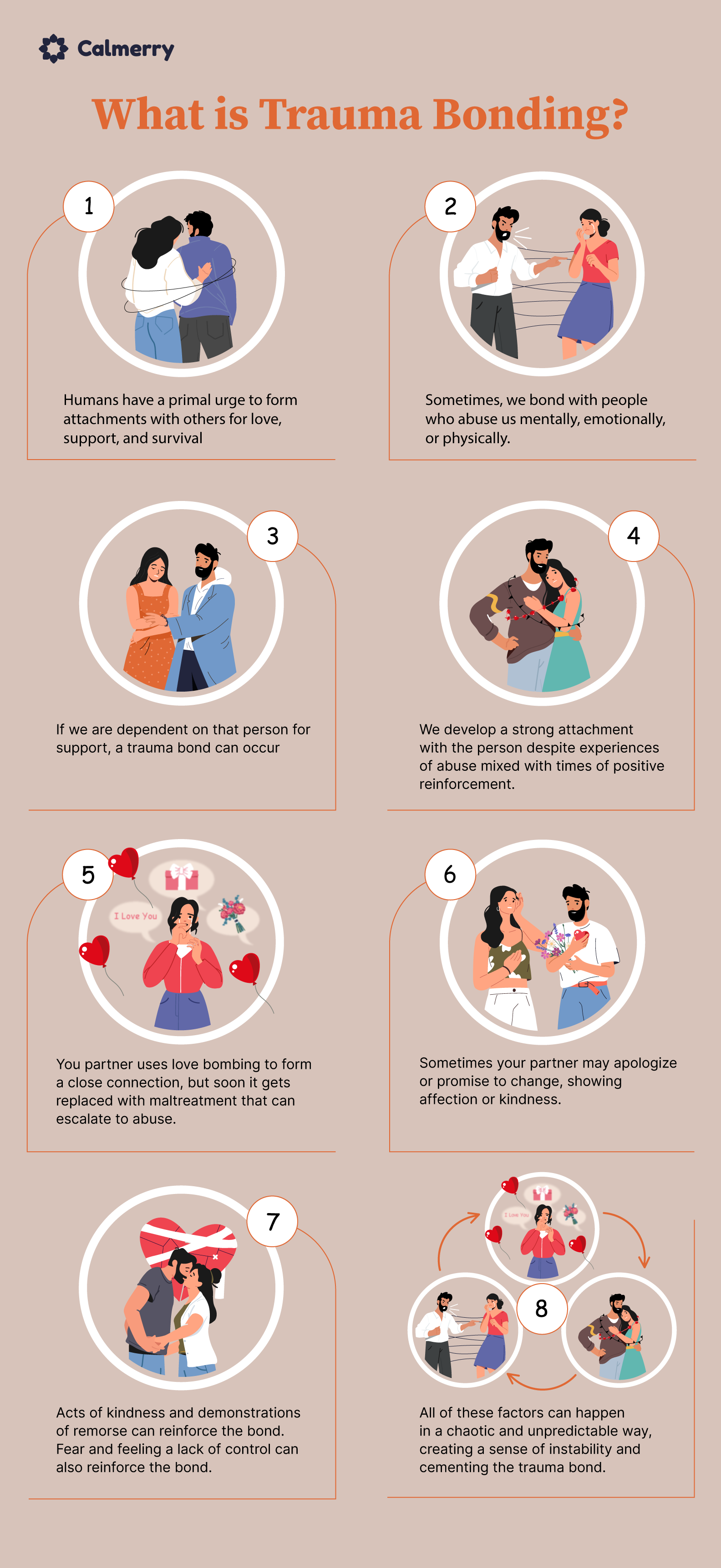
Trauma bonding examples and features
- An imbalance of power in the relationship
- Manipulative use of intermittent loving or kind and hostile behavior (this is sometimes referred to as the “cycle of abuse,” though this term inaccurately implies that abuse is predictable.)
- Social isolation creating vulnerability, poor self-concept, and a sense of dependence
- The victim or survivor’s self-blame for the negative interactions (and gratitude for the positive)
- The victim or survivor’s internalization of the other’s point of view (and loss of sense of self)
- Prior experiences of trauma in the victim or survivor’s life
- Continued feelings of love or abandonment after the abusive relationship has ended
- In some cases, there may be a sense of fear or loss of belief in the possibility of a safe and supportive relationship
Human trafficking is an example of an extreme power imbalance that can lead to trauma bonding. In situations like these, psychological coercion can change the brain, and any kindness is magnified.
This concept can also be applied to everyday relationships like friends, family members, and intimate partners.
And the bonding is not always one-sided. Often, both parties seem to develop an emotional connection, and the person inflicting the abuse will often blame-shift or make excuses for their behavior, such as “teaching you a lesson.”
Signs of trauma bonding
Chances are you’ve either been in or observed one of your friends or family members in a toxic relationship that, in retrospect, went on much longer than it should have. This phenomenon demonstrates the power of trauma bonds.
The way we emotionally, psychologically, and financially attach to other people makes the idea of just packing up and leaving a relationship that’s not good for you much more complex than you might first think.
With trauma bonding, there is an added complexity of boundary confusion and difficulty recognizing behavior that’s kind, loving, intimate, and safe versus abusive, toxic, offensive, and hateful.
Below are some warning signs to keep an eye out for.
1. You want to cut off the relationship but haven’t been able to
Whether it’s a relationship with a friend, partner, or family member, if you’ve been thinking that you’d be better off leaving someone behind but continue to not be able to cut them out of your life, that might be a sign of a trauma-bonded relationship.
It’s possible you don’t even like the other person, and you may have thought about leaving several times but ultimately couldn’t surmount an inexplicable pull to stay.
Or maybe you feel sick and full of panic when you’re away from them, even though being with them is toxic.
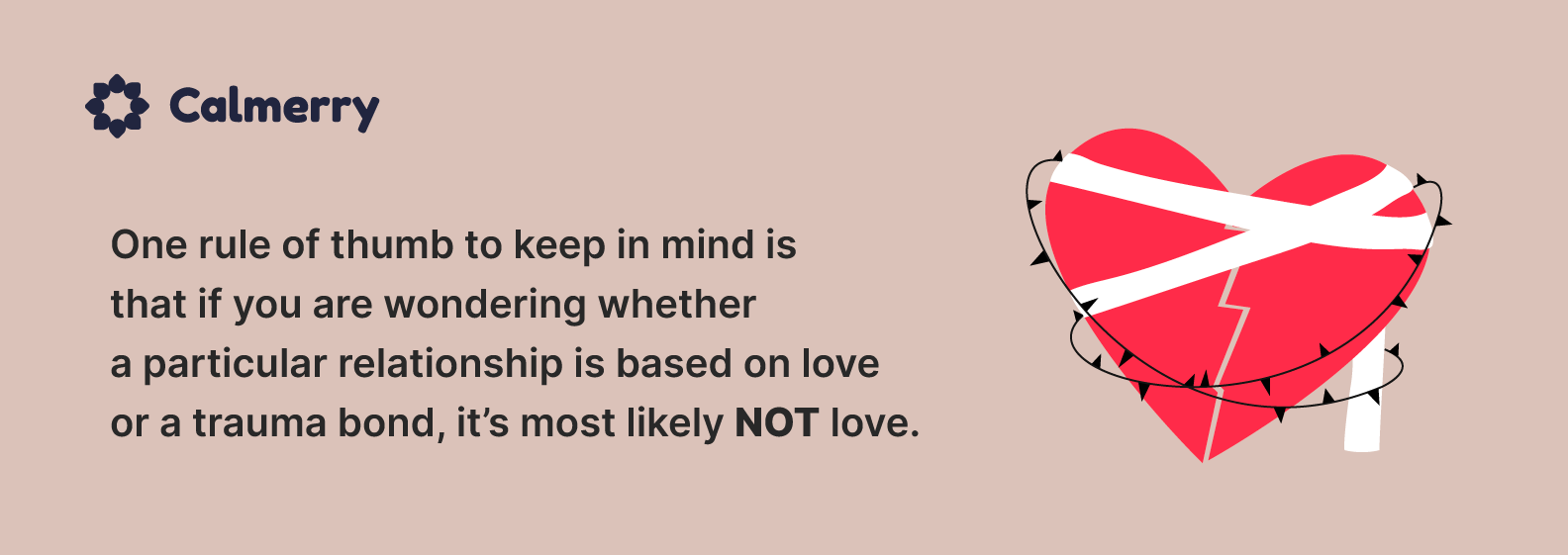
Of note, some people are in situations where they are too afraid to leave an abusive relationship. If this is the case for you, trust yourself to know what the best and safest decision is when it comes to making a decision to separate.
2. You make excuses for the other person’s bad behavior
If you’re constantly convincing yourself or other people that your relationship is healthy, or if you find yourself lying about the ways the other person behaves to protect their image, that’s a huge red flag.
You may think that it’s all acceptable because your bond is so strong, but remember that relationships built on trauma bonds do not transform into healthy and loving dynamics, no matter how much work you put into them.
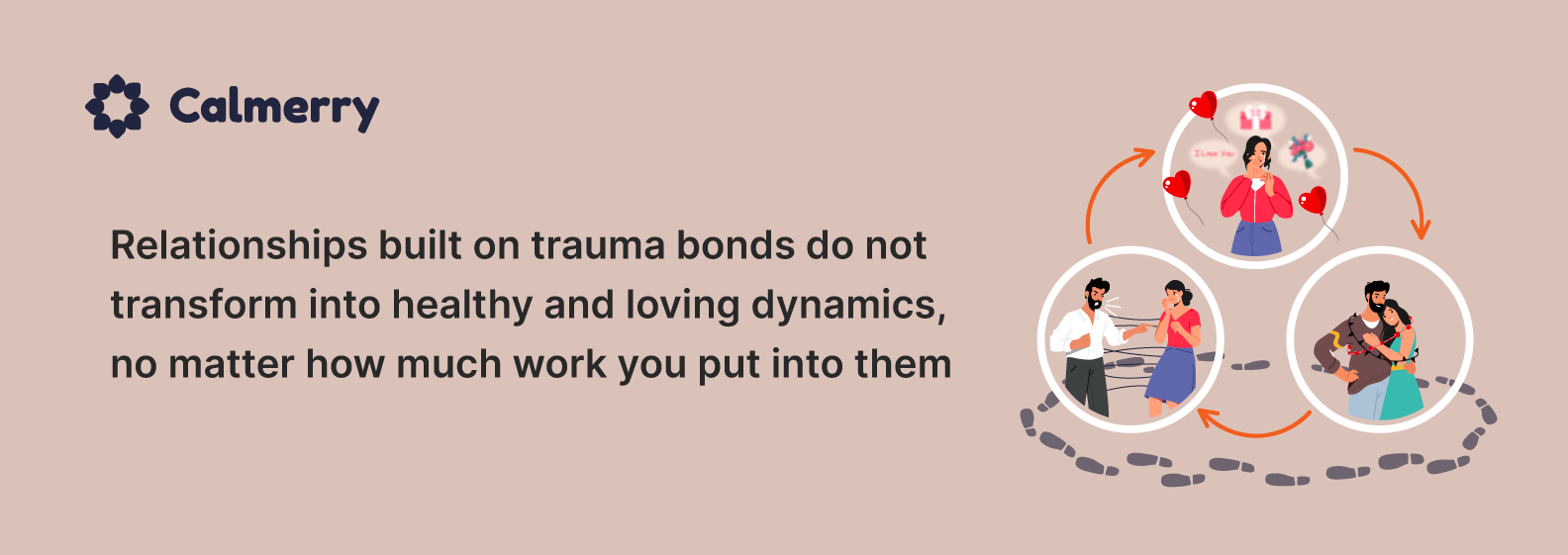
3. You’re stuck in the fantasy you developed early in the relationship
When you met this person, maybe you were thrilled that he was so attentive and caring. He brought you food and remembered every last detail about your friends. You were excited to have him be the father of your children one day and to give them the two-parent childhood you didn’t have.
These are the types of fantasies we develop at the beginning of a relationship.
When things start to go south, people often cling to the relationship because they are clinging to that idealized version. This person was going to come into your life, fill in the gaps, and give you just what you needed. It’s hard to let go of that.
Abusive partners sometimes come off as charming and charismatic. And unfortunately, they may begin a relationship by “love-bombing” you. They’ll make you feel safe, important, cared for, and loved while filling whatever emotional hole you’ve been struggling with. Maybe they’ll call you their soulmate and shower you with attention.
Then, the devaluation and abuse will start.
If you’re stuck in the past or always leaning on “what could be” with the other person, your relationship may be based on a trauma bond.
4. You feel isolated from the rest of the world
Isolation and threats to survival often strengthen the bond. It leads to a greater sense of dependence and belief in the demeaning and belittling things said to you. In these situations, a person’s self-esteem can plummet.
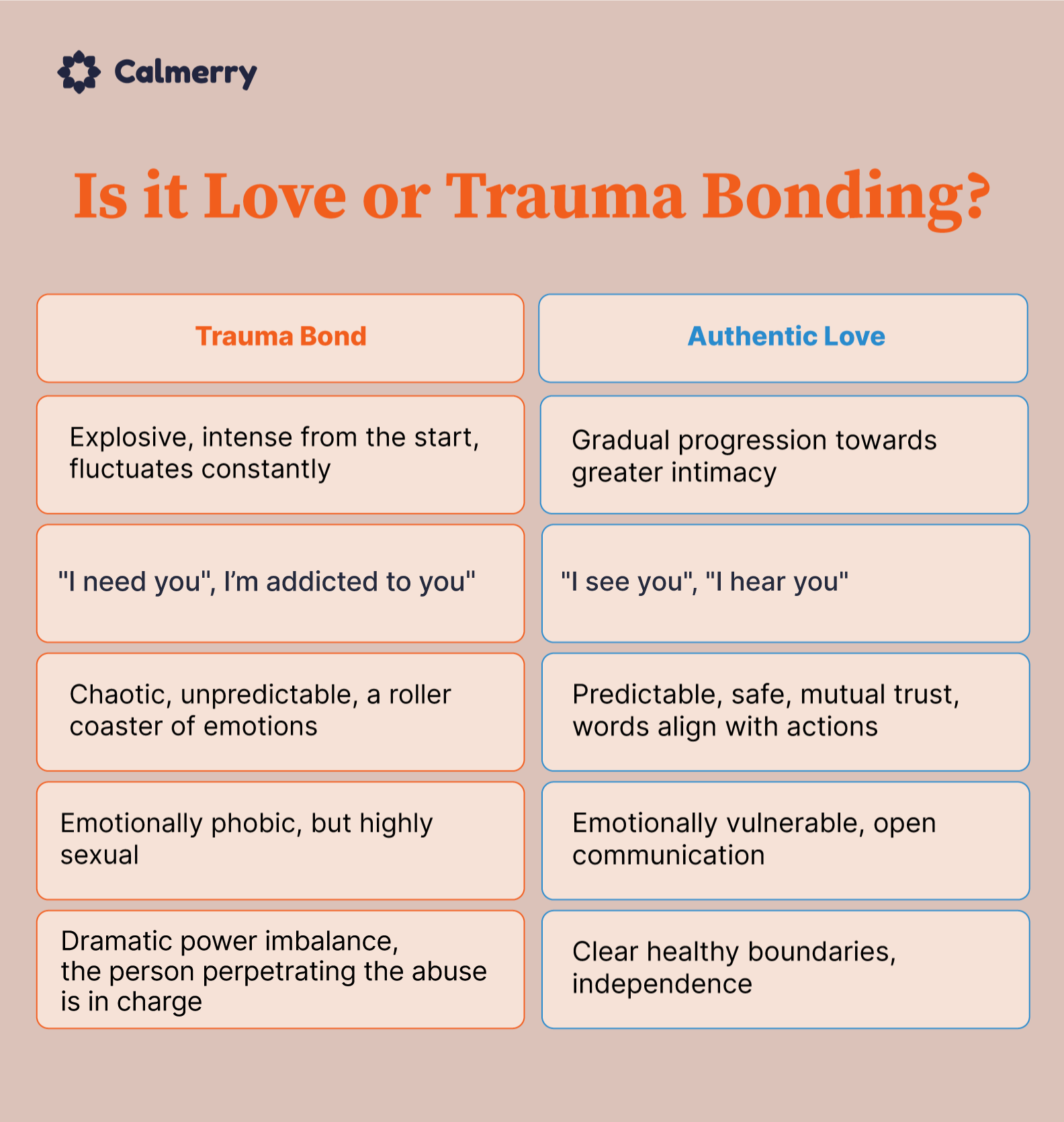
Eventually, you might stop interacting with others altogether–leaving people like law enforcement, healthcare providers, and even your family and friends feeling unsafe or untrustworthy.
5. You’re growing numb to the toxic dynamic and abuse
Traumatic and abusive relationships can leave people feeling afraid, confused, and lost. It’s extremely hard to pick up the pieces and learn how to set healthy boundaries or create a safe environment for yourself.
Instead, some people might dissociate or feel numb as a way to cope. You may even turn to alcohol or other mood-altering substances to get by.
If you’re beginning to settle into the mistreatment and feel that you deserve it or it’s all you’re going to get, that’s a sign of a trauma bond.
6. If a loved one was in this relationship, you’d want them out
Imagine your best friend was in this same relationship. Could you see the signs of abuse and toxicity from a mile away? Would you want them out?
If your relationship with another person is such that you wouldn’t wish it on any of your loved ones, it’s likely built on a trauma bond.
7. The relationship brings you back to toxic dynamics from childhood
Consider whether your current relationship has parallels with unhealthy or harmful relationships you had as a young child. When people are abused as young children, it can impact the types of relationships they form as an adult.
You might recognize that you’re repeating the same abusive dynamics that you had with a parent or caregiver when you were a child.
Some theorize that this happens because we are unconsciously trying to heal our past attachment wounds by getting into the same situation and hopefully making it better this time. Unfortunately, the trauma-bonded relationship won’t give you the type of healing that you are seeking.
What to do if you’re in a trauma-bonded relationship
It’s not easy to break a trauma bond once and for all – but it is possible. Below are some tips that might help you to break free.
Put your safety first
If you fear for your safety, work with your therapist or a trusted person to develop a safety plan for how to leave.
Limit the people you share the information with to the bare minimum, and protect yourself by not letting your partner in on your thinking.
Cut off contact
Once you begin the process of separation, your experience of the trauma bond may become more intense and draw you back to the person. The loss of this relationship will often feel like a deep and painful loss.
Stopping all communication (or as much as possible, depending on whether you have shared property, pets, or kids) is the best way to recover yourself.
Some people tend to wear rose-colored lenses when they look back on a toxic relationship and only remember the good times.
If that sounds like you, when you’re tempted to reach out, remind yourself of why you left. Trust that it will get easier with time.
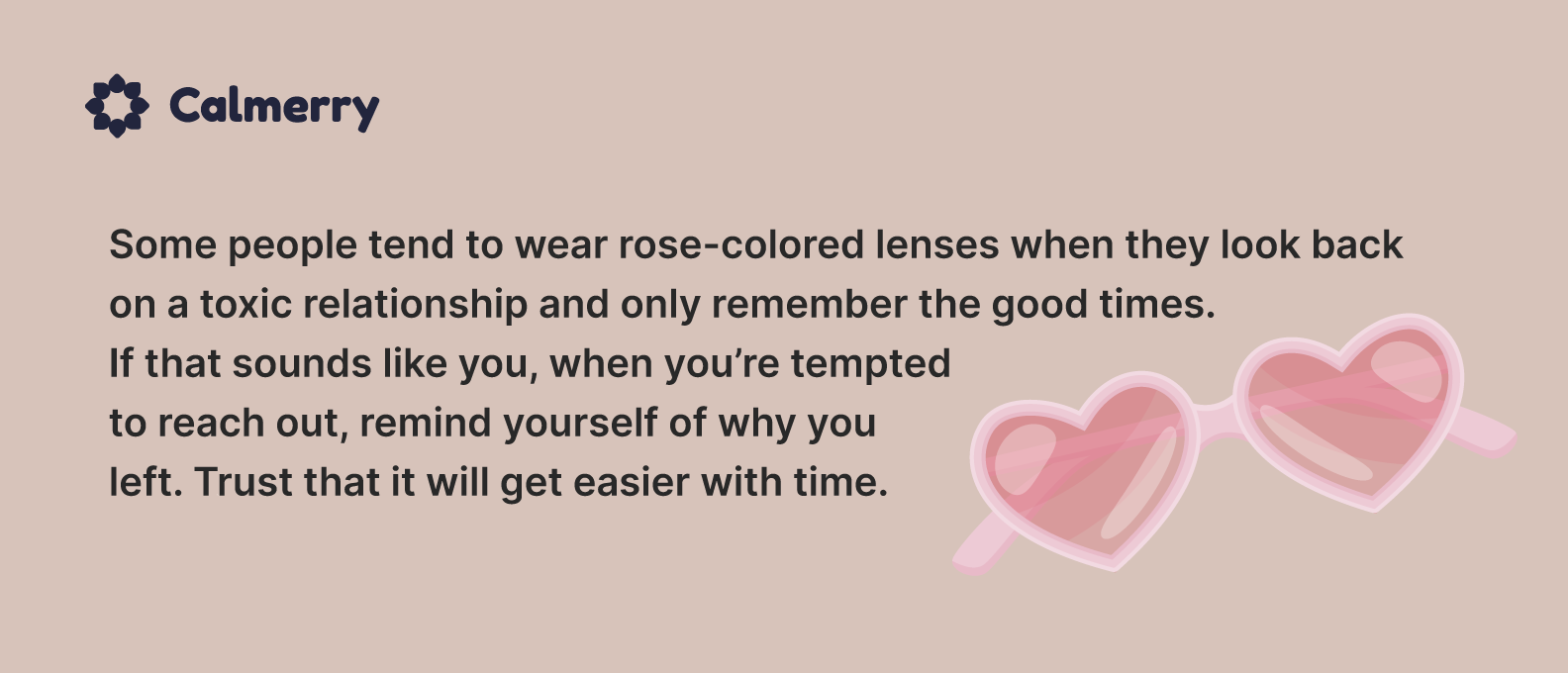
Write down your boundaries
Taking some time to journal about what you’re looking for in a friend or partner and what behavior you’ll compromise on versus what you absolutely won’t put up with is a great way to organize your thoughts and know what types of relationships you want to build going forward.
Think about interactions and behaviors in your trauma-bonded dynamic that you don’t want to repeat, and take note of any red flags that you can look out for in future partners.
Make space for healthy relationships
If you’re used to having toxic people in your life, and it feels normal to be demeaned and belittled by your loved ones, focus on developing relationships with people who offer you kindness, respect, and compassion.
Demonstrate those things in return, and you’ll develop a supportive network around you.
If you’re feeling alone, talk about this in therapy, and you can work together to process your feelings and come up with a plan. You might join a support group, connect with people from your faith, or meet up with people doing the activities you love to do.
– Kate Dubé, Licensed Clinical Social Worker (LCSW)
You can have a video call with an old friend and start there. You’ll be surprised at how open people can be when you reach out to connect.
When you’re coming out of a trauma-bonded relationship, you’ll be vulnerable and in a place of self-discovery.
That’s why we suggest focusing on developing solid, healthy, and stable friendships before venturing into the dating world. Building a strong support network is essential for your emotional well-being on the journey to healing.
Try something new
Isolation only strengthens the trauma bond and increases your dependence on a toxic and abusive relationship. If you’re able to put yourself out there and try something new.
Maybe a hiking group, language class, gym membership, yoga, painting, or any other activity that piques your interest – your self-esteem will grow.
As you engage in more self-care and activities that feel enriching, you’ll also have more to turn your attention to once you separate yourself from the trauma bond.
Educate yourself
Reading this article is a great start. As you begin to differentiate your trauma bond from feelings of love and respect, you’ll be better equipped to see your relationship for what it is and create the space you need to heal.
When you understand what’s pulling towards the relationship, you can also begin to work through any underlying issues and heal deeper wounds.
Talk to your therapist
You can always check that your online therapist has experience working with relationship abuse, trauma bonding, and attachment issues. If you feel a connection and sense of trust with them–that can go a long way toward healing.
If you haven’t started yet or aren’t sure what to expect in therapy, you’ll focus on finding yourself outside of this toxic dynamic and trauma bond.
You’ll understand some of the factors that drew you into the relationship and work through those, rebuild your self-esteem, and explore how to set healthy boundaries to develop relationships that nurture you and allow you to thrive.
online therapy
live video session



